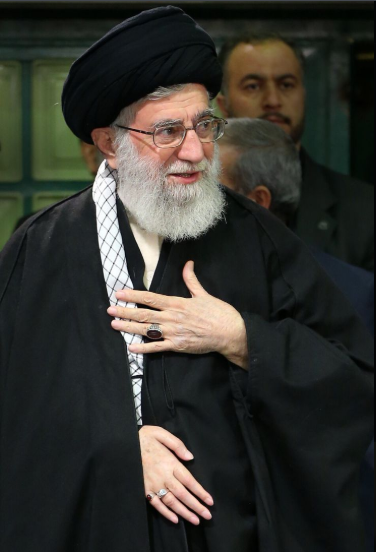– Mohammed Talha Siddi Bapa
In a world where democratic models, monarchy and tyranny dominate political discourse, the Islamic Republic of Iran stands apart with a governance structure rooted not in secular principles, party-based competition or dynastic rule, but in religious jurisprudence and revolutionary ideology. At the heart of this system lies the position of the Supreme Leader—Rahbar‑e‑Aala – a figure who wields immense influence over Iran’s domestic, judicial, military, and foreign affairs. Yet, the method of selecting this leader and the institutions that support his authority remain poorly understood, especially outside Iran.(Constitution of Iran article no 109 and 110)
This article explores Iran’s unique leadership structure, particularly the election of the Supreme Leader through the Assembly of Experts, the ideological formation of the Islamic Revolutionary Guard Corps (IRGC), and the contrast between this system and Western democratic norms.
Unlike most modern political systems where heads of state or government are chosen through direct elections or party‑driven parliamentary processes, Iran’s Supreme Leader is not elected by popular vote. Instead, he is chosen by a clerical body known as the Assembly of Experts (Majlis‑e‑Khobregan‑e‑Rahbari), composed of 88 senior Islamic scholars elected by the public for eight‑year terms.
However, this electoral process is far from open‑ended. Before candidates can run for a seat in the Assembly, they must be vetted and approved by the Guardian Council, a powerful oversight body that evaluates their religious qualifications, loyalty to the Islamic Republic, and alignment with the principle of Wilayat al‑Faqih – the governance of the Islamic jurist. This rigorous filtering mechanism ensures that only those deemed ideologically and theologically reliable make it to the ballot.
According to a Wikipedia report , during the most recent Assembly of Experts election, 510 applicants filed their nominations. Out of them, only 144 were approved by the Guardian Council to contest. Many reformist and moderate figures were disqualified – reflecting the regime’s desire to maintain ideological uniformity within this crucial institution.
Once elected, the Assembly of Experts holds the exclusive authority to appoint, supervise, and, theoretically, dismiss the Supreme Leader. In practice, however, no such dismissal has ever occurred since the formation of the Islamic Republic in 1979. This underscores the role of the Assembly as both a theological body and a guardian of revolutionary continuity.
Iran’s Constitution, particularly Articles 107 and 109, outlines the necessary qualifications for someone to ascend to the position of Supreme Leader. These include being a mujtahid (a high‑ranking Islamic jurist), possessing justice and piety, having political and social wisdom, and demonstrating the leadership skills necessary to manage the affairs of the Islamic Ummah (community).
This framework makes the position of the Supreme Leader distinct from both religious clerics and political figures in other systems. He embodies the convergence of spiritual authority and executive power, making him the cornerstone of Iran’s theocratic republic.
Theological Roots and the Misplaced Comparison
The modern Western model of democracy emerged as a reaction to the historical dominance of the Church in medieval Europe, where theology often suppressed scientific reasoning and intellectual dissent by citing biblical authority. In this context, secularism did not evolve as a neutral philosophical ideal, but as a reactionary safeguard – designed to liberate political life from religious absolutism and clerical authoritarianism.
As a result, many Western thinkers and institutions developed an instinctive suspicion toward any theological involvement in governance, associating it with a return to irrational clerical tyranny. This deeply embedded bias continues to shape how non-Western political systems, especially those with religious foundations, are perceived in global discourse.
However, applying this historical experience to Islamic models of governance – particularly Iran’s political structure – is a profound misconception. Unlike medieval Christianity, Islam never institutionalised a centralised Church that monopolised truth, suppressed inquiry, or persecuted science. On the contrary, Islamic civilization historically embraced a symbiotic relationship between revelation and reason, between spirituality and statecraft.
The Islamic tradition encouraged the integration of rational discourse, ethical law (Shari’ah), and public governance. The jurist-led leadership model in Iran is not a reversion to blind faith but a continuation of a worldview where spiritual values guide temporal authority. Understanding this distinction is crucial before comparing Iran’s theocratic framework to Western liberal democracies, which were born out of a specific Christian‑European context –not as universally applicable templates.
Ayatollah Ali Khamenei, Iran’s current Supreme Leader, has held the position since 1989. Now in his mid-eighties, he remains an active and influential figure. However, speculation about a leadership transition has intensified due to geopolitical tensions and concerns about internal succession planning. In recent months, Israeli airstrikes on Iranian assets and U.S. policy discussions have raised fears that Khamenei himself could be considered a strategic target as part of containment strategies (e.g., multiple Reuters analyses in June 2025).
As reported by various reliable outlets, Khamenei has quietly guided and mentored three members of the Assembly of Experts – without formally naming them – to prepare for a potential future transition. Notably, his son, Mojtaba Khamenei, though considered an influential religious scholar and organisational figure, has not been publicly endorsed as a successor. This absence of dynastic preference suggests a conscious effort by the establishment to uphold the system’s ideological and constitutional integrity rather than allow it to be influenced by familial inheritance.
According to Reuters, June 23, 2025, the deliberate distancing of Mojtaba from succession signals that Iran’s leadership system is meant to be rule-based and collective, not monarchic or hereditary – despite perceptions to the contrary in some Western media.
No discussion of Iran’s leadership structure would be complete without acknowledging the role of the Islamic Revolutionary Guard Corps (Sepah‑e Pasdaran‑e Inqilab‑e Islami), or IRGC. Established in May 1979 by the directive of Ayatollah Khomeini, the IRGC was created to protect the newly formed Islamic Republic not just from external threats but from internal deviations from its revolutionary path.
The IRGC operates parallel to Iran’s traditional military and is tasked with safeguarding the revolution’s ideological boundaries. It has its own army, navy, aerospace division, and intelligence wing. It also exerts considerable influence over Iran’s economy, media, and foreign policy – especially through its elite Quds Force.
According to Encyclopaedia Britannica, the Guard Corps was designed to ensure that no counter-revolutionary elements, whether domestic or foreign, could undermine the Islamic Republic. The Council on Foreign Relations highlights how the IRGC’s Quds Force supports ideological proxies throughout the Middle East.
While Iran’s model is rooted in religious legitimacy and revolutionary ideals, it stands in stark contrast to Western liberal democracies, where leadership is often decided through universal adult suffrage, party platforms, and political marketing. A 2023 New York Times report outlined the growing global concern over the presence of politicians with criminal backgrounds in parliaments across several democratic countries.
Iran’s leadership system, despite its limitations and controversies, presents an alternative model to Western democracy – one that seeks to embed ideological continuity, religious authority, and political stability within the same framework.
Bridging Values and Governance
The Iranian leadership model, centred around the Supreme Leader and rooted in Islamic jurisprudence, presents a compelling counter-narrative to dominant Western frameworks of governance. While not without challenges or criticisms, it seeks to prioritise moral leadership, continuity of vision, and ideological integrity – qualities often lost in populist and media-driven democracies. As global systems face crises of trust and coherence, Iran’s theocratic-republican hybrid offers a case study in how spiritual values can intersect with governance. The real challenge lies not in choosing between East or West, but in understanding the unique trajectories that shape each society’s search for just leadership.




